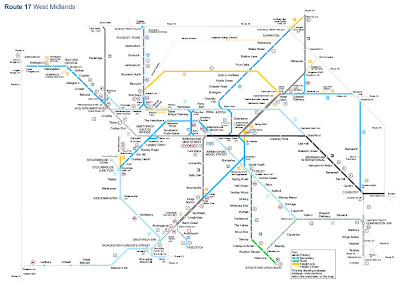Network Rail Strategic Business Plan Update
The document is not intended to be a full refresh of the 2007 Strategic Business Plan. Instead, it should be read in conjunction with the original plan and the supporting material that was provided with it.
http://www.networkrail.co.uk/aspx/4357.aspx
Relevant to Birmingham and the West Midlands is the route plan. This route plan from April supersedes the 1st November 2007 version in the SBP.

The route is bounded to the east and north by the WCML, the west by Shrewsbury and Hereford and the south by Oxford and Worcester.
http://www.networkrail.co.uk/browse%20documents/StrategicBusinessPlan/RoutePlans/2008/Route%2017%20-%20West%20Midlands.pdf
The importance of the West Midlands to the rail network is underlined in the Route Context statement. "The West Midlands route is the key hub at the centre of the national rail network, with long distance InterCity, Inter-urban rail and Suburban rail services passing through Birmingham".
Current passenger demand
The 2005 Route Utilisation Strategy (RUS)(http://www.wolverhampton.gov.uk/NR/rdonlyres/A5089C51-05E5-4F94-B231-0173992255A3/0/wmrus_final_jul05.pdf) showed that between 1995 and 2004 rail patronage on this route had grown by 44%, compared with the national average of 34%. Work journeys to central Birmingham increased from 12% to 20% between 1991 and 2004 with average annual growth at 3.9% between 1999 and 2004. Since 2004 however growth has increased still further with Centro supported services reporting a 6% growth and the Cross City Line reaching 10% growth for 2006-07. The average growth rate across other services on the route is currently 4.7%.
Proposed Strategy

Strategic Direction
In the SBP, Network Rail outline how they expect route 17 (the West Midlands area in map above) to see high levels of growth as journey times and performance levels improve. Their strategic direction to help deal with growth will be to lengthen trains and associated platform lengthening. This will also be coupled with re-signalling which they describe as a 'once once-in-35 year cost-effective opportunity to increase capacity'.
The table below shows platforms lengthening required to facilitate this growth.

http://www.networkrail.co.uk/browse%20documents/StrategicBusinessPlan/RoutePlans/2008/Route%2017%20-%20West%20Midlands.pdf
Most excitingly and reported in the Birmingham Post and Birmingham Mail are what Network Rail terms Long Term Opportunities and Challenges with schemes such as the chords to link the Camp Hill line to Moor Street and allow trains from Coventry and Wolverhampton to use Snow Hill or Moor Street.
Long term opportunities and challenges
We anticipate that accommodating growth in rail usage in the West Midlands will continue to be a significant challenge on the route, as employment and economic activity in central Birmingham continues to increase. As previously mentioned, the
preferred option to accommodate this increased growth is through longer train formations. However, both additional, and in some cases longer trains, may become more difficult to accommodate at Birmingham New Street.
Recognising this, Centro and Birmingham City Council, with our support, have commissioned a ‘West Midlands Rail Strategy Plan’ that examined possible short to long term capacity opportunities. This plan included the feasibility of developing a
north and south facing chord line that links the Camp Hill lines to Birmingham Moor Street (Snow Hill Lines). It also identified Birmingham Moor Street as a station that offers a low cost opportunity for additional platforms and stabling space to be
provided in the heart of Birmingham. Space exists for up to four eight car platforms to be installed at relatively low cost.
We are working with Centro, local authorities and London Midland on a ‘rail showcase’ project for the Cannock line between Walsall and Rugeley. The aim of this project is to deliver co-ordinated improvements to station facilities, expanded car
parks, longer and more frequent trains. We have additional aspirations to improve infrastructure and increase the line speed from 45 mph to 75 mph, improving performance and significantly reduced journey times. Our overall aspiration is to work with key stakeholders to develop appropriate rail strategies and then apply the process to other corridors.
The possible re-opening of core sections of the route between Round Oak and Walsall and, longer term, Walsall and Brownhills have been identified as routes that will release capacity across the West Midlands area.



Comments